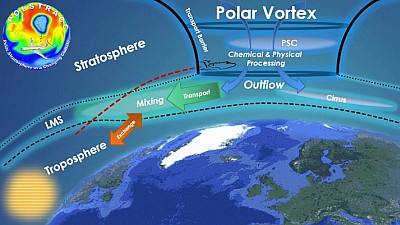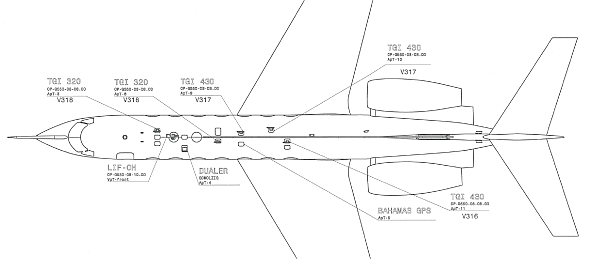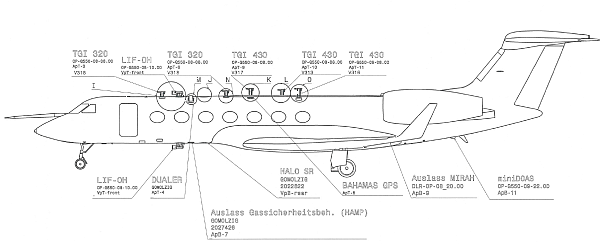
Mission status: Completed
Dr. Marcel Dorf, Max Planck Institute for Chemistry, Mainz
HALO Project Management: Martina Hierle
Postal address:
DLR Oberpfaffenhofen
Flugexperimente (FX)
Münchener Str. 20
82234 Weßling
Germany
Office phone:
+49 (0)8153 28-1792
HALO was operated from different bases during this mission:
The OMO mission with HALO consisted of two field campaigns: OMO-EU and OMO-Asia.
OMO-EU campaign phases:
| Mission phase | Dates |
|---|---|
| Preparation incl. EMI testing | 24 Nov 2014 - 21 Jan 2015 |
| Mission Oberpfaffenhofen | 22 Jan 2015 - 27 Jan 2015 |
| Dismounting of payload | 28 Jan 2015 - 30 Jan 2015 |
OMO-Asia campaign phases:
| Mission phase | Dates |
|---|---|
| Preparation incl. EMI testing | 26 May 2015 - 10 Jul 2015 |
| Mission Oberpfaffenhofen | 11 Jul 2015 - 20 Jul 2015 |
| Mission Paphos Phase 1 | 21 Jul 2015 - 1 Aug 2015 |
| Mission Gan | 1 Aug 2015 - 10 Aug 2015 |
| Mission Paphos Phase 2 | 10 Aug 2015 - 27 Aug 2015 |
| Dismounting of payload | 28 Aug 2015 - 4 Sep 2015 |
The OMO aircraft measurement campaign addressed the „self-cleaning capacity“ of the atmosphere. It focused on oxidation processes and air pollution chemistry downwind of South Asia during the summer monsoon. The self-cleaning mechanism converts natural and human-made pollutants into more soluble products that can be removed by rain. This is critical for air quality and climate change, both regionally and worldwide considering rapidly growing pollution emissions, especially in Asia.

HALO on the airport of Gan (Maldives)
during the OMO-Asia campaign
The measurements took place in July and August 2015 in the upper troposphere at 10-15 km altitude. The goal was to study the influence of convective clouds and rainfall on atmospheric composition during the monsoon. While soluble gases and aerosol particles can rain out, the removal efficiency is poorly known. Monsoon clouds can have a strong and large-scale impact on atmospheric chemistry through the vertical redistribution of sunlight, pollutants and humidity. The chemical, transport and deposition processes are investigated to advance computer models and improve air quality and climate change calculations.
The German institutions of the consortium belong to the Max Planck Society, the Helmholtz Association and universities that have a track record in airborne atmospheric research, for example in the Indian Ocean Experiment, conducted in the dry season, to which the OMO measurements can be contrasted. The consortium has recently developed a comprehensive set of instrumentation for the HALO aircraft.
The flight patterns included tracks across the Arabian Sea, the Arabian Peninsula, the Indian Ocean and the Mediterranean Sea to study zonal and meridional concentration gradients and large-scale impacts of the monsoon. Vertical (stack) flights were performed in regions of particular interest, so that a range of atmospheric conditions could be analyzed and the extent of pollution layers investigated. The measurements document long-distance pollution transports and their influence on regional-to-global atmospheric composition and climate.
| Scientific instrument acronym | Description | Principal investigator | Institution |
|---|---|---|---|
| HORUS | OH/HO2/NO2 | Hartwig Harder | MPIC, Mainz |
| AIR LIF | OH/HO2/NO2 | Frank Holland | FZ Jülich |
| PERCEAS | RO2 | Lola Andrés Hernández | Univ. Bremen |
| SR | Actinic Flux | Birger Bohn, Manfred Wendisch | FZ Jülich, Leipzig Univ. |
| FAIRO | Fast ozone measurement | Andreas Zahn | KIT |
| KMS | OVOC | Andreas Zahn | KIT |
| MGC | NMVOC | Jonathan Williams | MPIC, Mainz |
| TRIHOP | Total Peroxides, H2O2 / CO, HCHO, CO2 | Horst Fischer | MPIC, Mainz |
| IPA-NOY | NOY | Helmut Ziereis | DLR-IPA |
| PAN-MS | SO2, HNO3 | Hans Schlager | DLR-IPA |
| CPC | Condensation particle counter | Hans Schlager | DLR-IPA |
| MIRAH | VOC + isotopes | Ralf Koppmann | Univ. Wuppertal |
| miniDOAS | Differential Optical Absorption Spectroscopy | Klaus Pfeilsticker | Univ. Wuppertal |
| BAHAMAS | HALO basic data acquisition system | Andreas Giez | DLR-FX |

HALO cabin layout for OMO


HALO exterior configuration for POLSTRACC
OMO-EU
| Aircraft registration | Date | Take off - Landing / UT | Total flight time / h | From - To | Mission # |
|---|---|---|---|---|---|
| D-ADLR | 2015-01-21 | 10:45:00 - 13:00:00 | 2.250 | EDMO - EDMO | Flight test |
| D-ADLR | 2015-01-24 | 10:15:00 - 13:40:00 | 3.417 | EDMO - EDMO | Mission flight |
| D-ADLR | 2015-01-25 | 09:30:00 - 15:10:00 | 5.667 | EDMO - EDMO | Mission flight |
| D-ADLR | 2015-01-27 | 10:30:00 - 15:25:00 | 4.917 | EDMO - EDMO | Mission flight |
OMO-ASIA
| Aircraft registration | Date | Take off - Landing / UT | Total flight time / h | From - To | Mission # |
|---|---|---|---|---|---|
| D-ADLR | 2015-07-10 | 07:40:00 - 09:30:00 | 1.833 | EDMO - EDMO | Mission flight |
| D-ADLR | 2015-07-13 | 09:35:00 - 11:55:00 | 2.333 | EDMO - EDMO | Mission flight |
| D-ADLR | 2015-07-16 | 10:00:00 - 12:40:00 | 2.667 | EDMO - EDMO | Mission flight |
| D-ADLR | 2015-07-21 | 09:00:00 - 12:25:00 | 3.417 | EDMO - LCPH | Mission flight |
| D-ADLR | 2015-07-25 | 05:55:00 - 11:10:00 | 5.250 | LCPH - LCPH | Mission flight |
| D-ADLR | 2015-07-28 | 06:10:00 - 14:00:00 | 7.833 | LCPH - LCPH | Mission flight |
| D-ADLR | 2015-08-01 | 05:50:00 - 14:35:00 | 8.750 | LCPH - VRMG | Mission flight |
| D-ADLR | 2015-08-06 | 02:00:00 - 06:40:00 | 4.667 | VRMG - OBBI | Mission flight |
| D-ADLR | 2015-08-06 | 07:45:00 - 12:55:00 | 5.167 | OBBI - VRMG | Mission flight |
| D-ADLR | 2015-08-08 | 07:30:00 - 11:25:00 | 3.917 | VRMG - VRMG | Mission flight |
| D-ADLR | 2015-08-09 | 01:50:00 - 06:30:00 | 4.667 | VRMG - OBBI | Mission flight |
| D-ADLR | 2015-08-09 | 07:40:00 - 12:35:00 | 4.917 | OBBI - VRMG | Mission flight |
| D-ADLR | 2015-08-10 | 04:50:00 - 09:35:00 | 4.750 | VRMG - OBBI | Mission flight |
| D-ADLR | 2015-08-10 | 10:55:00 - 14:30:00 | 3.583 | OBBI - LCPH | Mission flight |
| D-ADLR | 2015-08-13 | 06:00:00 - 14:55:00 | 8.917 | LCPH - LCPH | Mission flight |
| D-ADLR | 2015-08-15 | 05:50:00 - 15:10:00 | 9.333 | LCPH - LCPH | Mission flight |
| D-ADLR | 2015-08-18 | 06:15:00 - 15:10:00 | 8.917 | LCPH - LCPH | Mission flight |
| D-ADLR | 2015-08-23 | 05:55:00 - 12:40:00 | 6.750 | LCPH - LCPH | Mission flight |
| D-ADLR | 2015-08-25 | 06:05:00 - 14:35:00 | 8.500 | LCPH - LCPH | Mission flight |
| D-ADLR | 2015-08-27 | 08:40:00 - 14:35:00 | 5.917 | LCPH - EDMO | Mission flight |
Press release German Embassy Nicosia (August 11, 2015):
German research aircraft in Cyprus
Press release Max-Planck-Institut für Chemie (May 17, 2015)
Flying 100,000 kilometers through the monsoon
Report in „in-cyprus“ (August 14, 2015):
Monsoon research in Paphos
Report on DLR-FX homepage (August 6, 2015):
HALO auf Kampagne „OMO-Asien“
Press release DLR (July 17, 2015):
Forschungsflugzeug HALO: Auf der Langstrecke für Messungen im asiatischen Sommermonsun